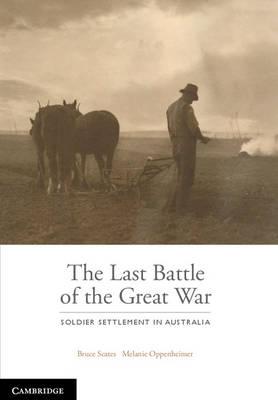Schemes for settling returned soldiers on the land were introduce Soldier Settlement in Australia starting in 1916 to provide employment for discharged men now returning from overseas, and for the expected tens of thousands more expected. The schemes were different in each state and the loans to settlers were backed by the Commonwealth.

Hardback 322 pp RRP: $59.95
After an overview of the background to Soldier Settlement the study moves on to a detailed examination of its application in New South Wales, previously only dealt with in a number of local studies. The book is organized and written to a high standard, as would be expected from the Chairs of History at Monash University (Bruce Scates) and Flinders University (Melanie Oppenheimer). The authors have chosen not to write an administrative history of soldier settlement in New South Wales, but to take as the study’s central characters the soldier settlers themselves, their families and the government inspectors who dealt with them on a routine basis. They have set out to rescue the ordinary settler from obscurity’.
Using previously unopened archives, in particular the NSW Lands Department Records, they have made thousands of individual life stories the foundation of the study, and to ‘situate it in history’s “narrative turn”.
The government’s objective was to provide employment for returning soldiers and at the same time to discourage them from congregating and forming a troublesome ‘class consciousness’. There was a widely held view that clearing and living on a block of land would encourage self-sufficiency and self-respect, and also reduce the amount of financial support required. The aim was to create a class of hardy, independent, yeoman farmers such as existed on the rich soils of Europe. Unfortunately, the harsh and variable Australian climate and the often -marginal lands used for soldier settlement were completely unsuited to achieving this idyllic vision.
Many of the settlers were physically disabled, as well as suffering emotionally from the War, and it is not surprising that about half failed. Through the narratives of the settlers, their wives and the government inspectors, this study examines the settlers themselves, their problems on the land and in dealing with a well-intentioned but financially stressed government struggling to recover its loans.
The treatment of soldier settlement is balanced: those settlers with farming experience and those unhappily without; the ‘triers’ and the ‘wasters’; the honest men and the ‘bounders’, and the government departments and inspectors who were sometimes ruthless in demanding loan repayment and ultimately evicting settlers, but also often sympathetic and supportive. The overall impression is that success was often unachievable and that thousands of returned soldiers and their families fought a last battle they could not win.
Reviewed for RUSIV by Roger Buxton, July 2017
Contact Royal United Services Institute about this article.






